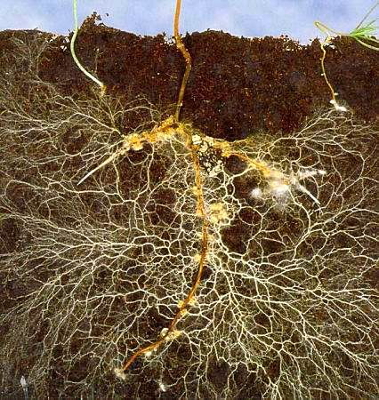
How nutrients move into plants
 Now that you
understand how
mobile nutrients are in the soil, it'll make more sense when I write about
how those nutrients get into roots. Root hairs (tiny roots)
are constantly growing, searching for new areas full of soil
nutrients so they can trade for cations and suck up anions.
The roots use calcium as a way of determining whether they're
growing in a good direction --- if calcium stops coming in (for
example, if the root hits a rock), the root hair stops growing.
Now that you
understand how
mobile nutrients are in the soil, it'll make more sense when I write about
how those nutrients get into roots. Root hairs (tiny roots)
are constantly growing, searching for new areas full of soil
nutrients so they can trade for cations and suck up anions.
The roots use calcium as a way of determining whether they're
growing in a good direction --- if calcium stops coming in (for
example, if the root hits a rock), the root hair stops growing.
At the same time
they're growing, the root hairs are exuding substances that help
ease their way between soil particles and that also help in other
ways. The root exudates ooze between soil particles and help
dissolve phosphorus, aid in the uptake of metals, and feed
microorganisms that make other nutrients more available. As
I mentioned in yesterday's post, the roots are also pumping out
hydrogen ions to trade for cations in the soil; and (less
importantly), roots pump out hydroxyl ions to trade for
negatively-charged nutrients.
Mycorrhizal fungi act
like extension of the root hairs during this nutrient-uptake
process. The tiny fungi are thin enough and long enough to
vastly extend the reach of the plant roots, and they're also good
at bringing in immobile nutrients like phosphorus, copper, and  nickel that would be
tough for plants to suck up on their own. Mychorrhizal fungi
also help out by digesting organic matter to free up nutrients,
making yet more nutrients available for plants.
nickel that would be
tough for plants to suck up on their own. Mychorrhizal fungi
also help out by digesting organic matter to free up nutrients,
making yet more nutrients available for plants.
As if all of the
above methods of getting nutrients aren't complicated enough,
plants also have to deal with weeding out nonessential nutrients
(like heavy metals) that would compete with essential nutrients in
the plant. Some of the exudates released by roots are used
to bind these nonessential nutrients into the soil so they become
unavailable, and mychorrhizae also help out with this binding.
Why should the
gardener care about all this microscopic action? First, it's
handy to understand how important microorganisms are in teaming
with your plants so you'll spend energy keeping the microbes happy
(with lack of tilling, the addition of organic matter, etc.)
But you should also be aware that the work of soil microorganisms
and mychorrhizal fungi slows down drastically during cool weather,
so your plants will have more trouble finding nutrients in early
spring. That might be a good time to pay more attention to
ensuring easily-soluble nutrients are available right up against
seedlings' roots so they can suck up nitrogen without bothering
their sleeping fungal neighbors.
| This
post is part of our Teaming
with Nutrients lunchtime series.
Read all of the entries: |
Want more in-depth information? Browse through our books.
Or explore more posts by date or by subject.
About us: Anna Hess and Mark Hamilton spent over a decade living self-sufficiently in the mountains of Virginia before moving north to start over from scratch in the foothills of Ohio. They've experimented with permaculture, no-till gardening, trailersteading, home-based microbusinesses and much more, writing about their adventures in both blogs and books.
Want to be notified when new comments are posted on this page? Click on the RSS button after you add a comment to subscribe to the comment feed, or simply check the box beside "email replies to me" while writing your comment.

Hi,
just stumbled upon the beautiful picture of the seedling with root hairs on your page. Do you know where it is from? We are interested in using it for an exhibition text panel.
Cheers Anne